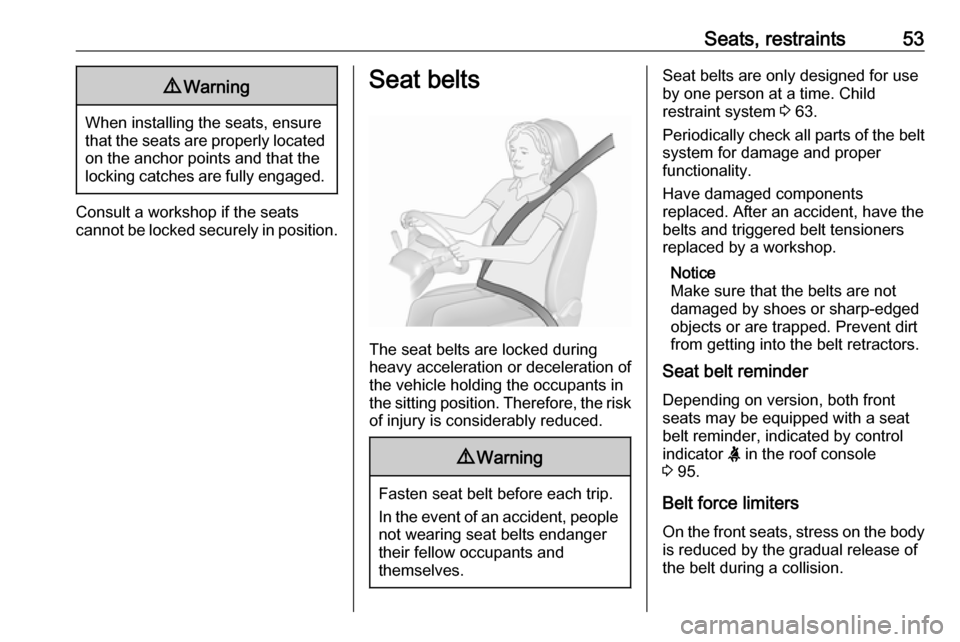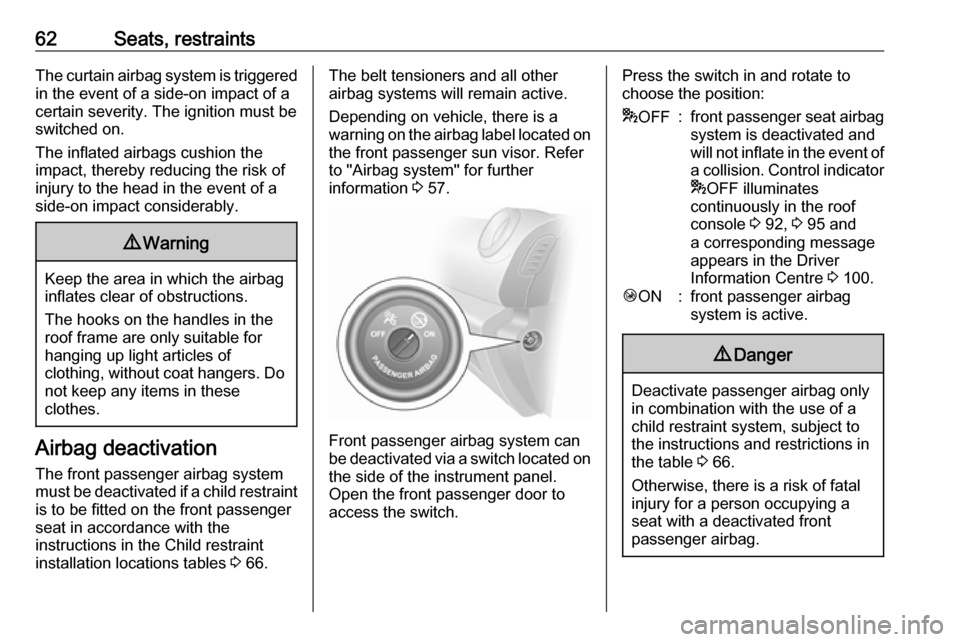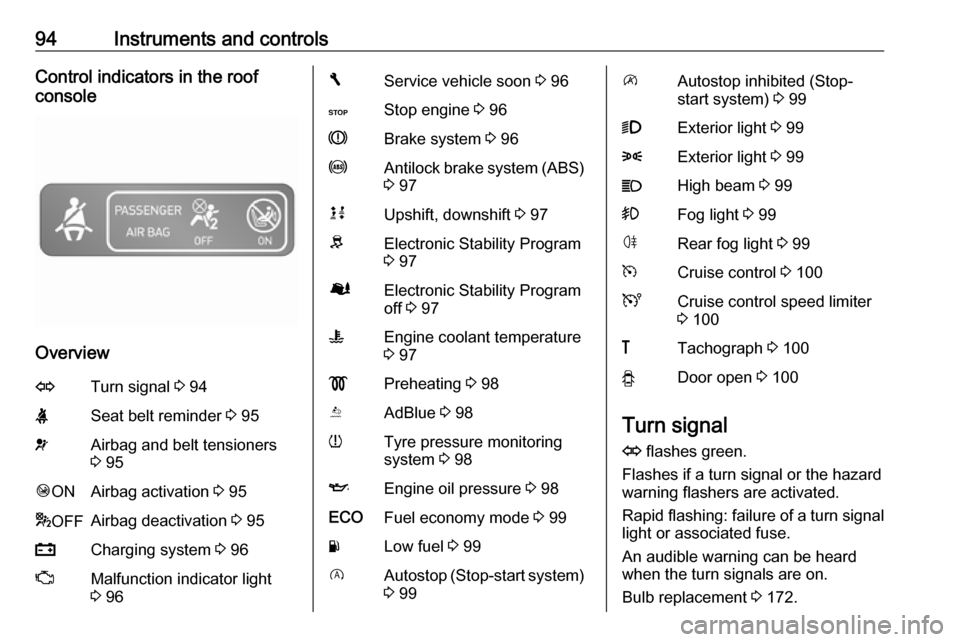roof VAUXHALL VIVARO 2017.5 Owner's Manual
[x] Cancel search | Manufacturer: VAUXHALL, Model Year: 2017.5, Model line: VIVARO, Model: VAUXHALL VIVARO 2017.5Pages: 231, PDF Size: 5.52 MB
Page 48 of 231

46Seats, restraints
● Sit with buttocks as far backagainst the backrest as possible.
Adjust the distance between the
seat and the pedals so that legs
are slightly angled when pressing
the pedals. Slide the front
passenger seat as far back as
possible.
● Set seat height high enough to have a clear field of vision on allsides and of all display
instruments. There should be at
least one hand of clearance
between head and the roof
frame. Thighs should rest lightly
on the seat without pressing into
it.
● Sit with shoulders as far back against the backrest as possible.Set the backrest rake so that it is
possible to reach the steering
wheel with arms slightly bent.
Maintain contact between
shoulders and the backrest when turning the steering wheel. Do
not angle the backrest too far
back. We recommend a
maximum rake of approx. 25°.
● Adjust seat and steering wheel in
a way that the wrist rests on top
of the steering wheel while the
arm is fully extended and
shoulders on the backrest.
● Adjust the steering wheel 3 83.
● Adjust the head restraint 3 44.
● Adjust the height of the seat belt 3 54.
● Adjust the lumbar support so that
it supports the natural shape of
the spine 3 46.
Seat adjustment Drive only with engaged seats and
backrests.Longitudinal adjustment
Pull handle, slide seat, then release
handle.
Try to move the seat back and forth to ensure that the seat is locked in place.
Page 55 of 231

Seats, restraints539Warning
When installing the seats, ensure
that the seats are properly located
on the anchor points and that the
locking catches are fully engaged.
Consult a workshop if the seats
cannot be locked securely in position.
Seat belts
The seat belts are locked during
heavy acceleration or deceleration of
the vehicle holding the occupants in
the sitting position. Therefore, the risk of injury is considerably reduced.
9 Warning
Fasten seat belt before each trip.
In the event of an accident, people
not wearing seat belts endanger their fellow occupants and
themselves.
Seat belts are only designed for use
by one person at a time. Child
restraint system 3 63.
Periodically check all parts of the belt system for damage and proper
functionality.
Have damaged components
replaced. After an accident, have the
belts and triggered belt tensioners
replaced by a workshop.
Notice
Make sure that the belts are not
damaged by shoes or sharp-edged
objects or are trapped. Prevent dirt
from getting into the belt retractors.
Seat belt reminder
Depending on version, both front
seats may be equipped with a seat
belt reminder, indicated by control
indicator X in the roof console
3 95.
Belt force limiters On the front seats, stress on the body
is reduced by the gradual release of
the belt during a collision.
Page 63 of 231

Seats, restraints619Warning
Optimum protection is only
provided when the seat is in the
proper position.
Seat position 3 45.
Keep the area in which the airbag
inflates clear of obstructions.
Fasten the seat belt correctly and
engage securely. Only then is the
airbag able to protect.
Side airbag system
The side airbag system consists of an
airbag in each front seat backrest.
This may be identified by the word
AIRBAG .
The side airbag system is triggered in the event of an accident of a certain
severity. The ignition must be
switched on.
The inflated airbags cushion the
impact, thereby reducing the risk of
injury to the upper body and pelvis in
the event of a side-on collision
considerably.
9 Warning
Keep the area in which the airbag
inflates clear of obstructions.
Notice
Only use protective seat covers that have been approved for the vehicle.Be careful not to cover the airbags.
Curtain airbag system
The curtain airbag system consists of an airbag in the roof frame on each
side. This may be identified by the
word AIRBAG on the headlining trim.
Page 64 of 231

62Seats, restraintsThe curtain airbag system is triggeredin the event of a side-on impact of a
certain severity. The ignition must be
switched on.
The inflated airbags cushion the
impact, thereby reducing the risk of
injury to the head in the event of a
side-on impact considerably.9 Warning
Keep the area in which the airbag
inflates clear of obstructions.
The hooks on the handles in the
roof frame are only suitable for
hanging up light articles of
clothing, without coat hangers. Do not keep any items in these
clothes.
Airbag deactivation
The front passenger airbag system must be deactivated if a child restraint
is to be fitted on the front passenger
seat in accordance with the
instructions in the Child restraint
installation locations tables 3 66.
The belt tensioners and all other
airbag systems will remain active.
Depending on vehicle, there is a
warning on the airbag label located on the front passenger sun visor. Refer
to "Airbag system" for further
information 3 57.
Front passenger airbag system can
be deactivated via a switch located on the side of the instrument panel.
Open the front passenger door to
access the switch.
Press the switch in and rotate to
choose the position:* OFF:front passenger seat airbag
system is deactivated and
will not inflate in the event of
a collision. Control indicator
* OFF illuminates
continuously in the roof
console 3 92, 3 95 and
a corresponding message
appears in the Driver
Information Centre 3 100.Ó ON:front passenger airbag
system is active.9 Danger
Deactivate passenger airbag only
in combination with the use of a
child restraint system, subject to
the instructions and restrictions in
the table 3 66.
Otherwise, there is a risk of fatal
injury for a person occupying a
seat with a deactivated front
passenger airbag.
Page 73 of 231

Storage71StorageStorage compartments................71
Instrument panel storage ...........71
Glovebox ................................... 72
Cupholders ................................ 73
Front storage ............................. 73
Door panel storage ....................74
Underseat storage .....................74
Overcab storage ........................76
Load compartment .......................76
Load compartment cover ...........77
Lashing eyes ............................. 77
Safety net .................................. 78
Load compartment grille ............79
Warning triangle ........................80
First aid kit ................................. 80
Roof rack system .........................80
Roof rack ................................... 80
Loading information .....................80Storage compartments9Warning
Do not store heavy or sharp
objects in the storage
compartments. Otherwise, the
storage compartment lid could
open and vehicle occupants could be injured by objects being thrown
around in the event of hard
braking, a sudden change in
direction or an accident.
Instrument panel storage
Storage compartments, pockets and
trays are located in the instrument
panel.
A coin holder may be located on the
instrument panel.
A phone holder may be located on the instrument panel.
Page 75 of 231

Storage73Cupholders
Cupholders are located at both ends
of the instrument panel, centrally in the lower instrument panel, and
depending on version, also in the
door pockets and in the rear seat
area.
Additional cupholders are located on
the back of the folded down centre
rear seat 3 73, 3 49.
The cupholders can also be used to hold the portable ashtray unit.
Remove the portable ashtray unit to
use the cupholders.
Ashtrays 3 88.
Front storage
Coat hooks are located on the cabin
bulkhead and on the grab handles in
the roof lining.
Folding centre seatback The front centre passenger seat
backrest, when folded fully forwards, features a storage compartment,
cupholder and a document tray.
Seat folding 3 48.9 Warning
When the front centre passenger
seat is in the folded position, the front passenger airbag system
must be deactivated.
Airbag deactivation 3 62.
Close the instrument panel cupholder
before folding down the backrest.
Press button (arrowed) on rear side of
backrest to unlock the document tray
and access the storage
compartments.
To install the document tray, insert
the end piece(s) into any of the slots
by the cupholder.
Page 80 of 231

78Storage
Depending on vehicle, lashing eyes
may be located behind a trim panel in
the sidewall. To access lashing eye,
remove the trim panel by pulling it
upwards and place it in one of the rear storage pockets.The maximum force applied to the
lashing eyes should not exceed
500 daN/5 kN/5000 N.
Depending on country, the maximum
force may be shown on a label.
Notice
Specifications on the label always
have priority over those given in this manual.
Loading information 3 80.
Safety net
The safety net can be installed behind the front seats or the rear seats.
Passengers must not be transported
behind the safety net.
Installing
Release the covers in the roof lining
(using a flat blade screwdriver) to
access the mountings, then insert the
load compartment net rods into the
left and right mounting locations and secure.
Page 82 of 231

80StorageWarning triangle
The warning triangle can be
accommodated in the space under
the seats.
Underseat storage 3 74.
First aid kit
The first aid kit can be accommodated
in the space under the seats.
Underseat storage 3 74.Roof rack system
Roof rackFor safety reasons and to avoid
damage to the roof, the vehicle
approved roof rack system is
recommended. For further
information, contact your workshop.
Follow the installation instructions
and remove the roof rack when not in
use.
Notice
If tyres of size 215/60 R17 C are
fitted, consult a workshop before
installing a roof rack.
Refer to "Loading information" below
for further information.Loading information
● Heavy objects in the load compartment should be evenlydistributed and placed as far
forward as possible. If objects
can be stacked, the heavier
objects should be placed at the bottom.
● Secure objects with lashing straps attached to lashing eyes
3 77.
● Secure loose objects in load compartment to prevent sliding.
● When transporting objects in the load compartment, the backrestsof the rear seats must not beangled forward.
● Do not allow the load to protrude above the upper edge of the
backrests.
● Do not place any objects on the instrument panel.
● The load must not obstruct the operation of the pedals, parking
brake and gear selector, or
Page 83 of 231

Storage81hinder the freedom of movement
of the driver. Do not place any
unsecured objects in the interior.
● Do not drive with an open load compartment. In addition, the
number plate is only
distinguishable and illuminated correctly if the doors are closed.9 Warning
Always make sure that the load in
the vehicle is securely stowed.
Otherwise objects can be thrown
around inside the vehicle and
cause personal injury or damage
to the load or car.
● The payload is the difference between the permitted gross
vehicle weight (see identification
plate 3 204) and the EC kerb
weight.
To calculate the payload, enter
the data for your vehicle in the
Weights table at the front of this
manual.
The EC kerb weight includes
weights for the driver (68 kg),
luggage (7 kg) and all fluids (fuel
tank 90% full).
Optional equipment and
accessories increase the kerb
weight.
● Driving with a roof load increases
the sensitivity of the vehicle to
cross-winds and has a
detrimental effect on vehicle
handling due to the vehicle's
higher centre of gravity.
Distribute the load evenly and
secure it properly with retaining
straps. Adjust the tyre pressure
and vehicle speed according to
the load conditions. Check and
retighten the straps frequently.
Do not drive faster than 75 mph.
The permissible roof load is
200 kg for H1 Roof height
variants and 150 kg for H2 Roof
height variants (excludes
Platform cab conversions). The
roof load is the combined weight
of the roof rack and the load.
Page 96 of 231

94Instruments and controlsControl indicators in the roof
console
Overview
OTurn signal 3 94XSeat belt reminder 3 95vAirbag and belt tensioners
3 95Ó ONAirbag activation 3 95* OFFAirbag deactivation 3 95pCharging system 3 96ZMalfunction indicator light
3 96FService vehicle soon 3 96CStop engine 3 96RBrake system 3 96uAntilock brake system (ABS)
3 97kjUpshift, downshift 3 97RElectronic Stability Program
3 97ØElectronic Stability Program
off 3 97WEngine coolant temperature
3 97!Preheating 3 98YAdBlue 3 98wTyre pressure monitoring
system 3 98IEngine oil pressure 3 98ECOFuel economy mode 3 99YLow fuel 3 99DAutostop (Stop-start system)
3 99\Autostop inhibited (Stop-
start system) 3 999Exterior light 3 998Exterior light 3 99CHigh beam 3 99>Fog light 3 99øRear fog light 3 99mCruise control 3 100UCruise control speed limiter
3 100&Tachograph 3 100yDoor open 3 100
Turn signal
O flashes green.
Flashes if a turn signal or the hazard
warning flashers are activated.
Rapid flashing: failure of a turn signal
light or associated fuse.
An audible warning can be heard
when the turn signals are on.
Bulb replacement 3 172.